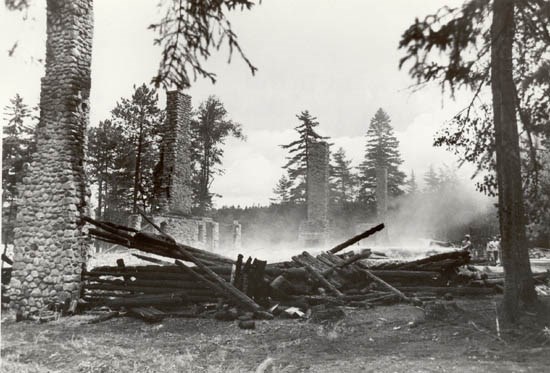
NPS Photo
Wickyup (Richard E. Byrd House)
Vicinity of East Sullivan, ME
Designated an NHL: August 29, 1970
Designation withdrawn: March 5, 1986
From 1937, the Wickyup estate served as the summer home of Admiral Richard E. Byrd and his family. Byrd, a pioneer aviator and polar explorer, planned three of his Antarctic expeditions at Wickyup. He also wrote his last book, Alone, here and drafted what became the Antarctic Treaty of 1959.
Byrd was a pioneer in the development of long-range, transoceanic, and high altitude flying and was the first to fly over both the North and South Poles. In his Antarctic expeditions, he explored or directed the exploration of more previously unseen lands than any other individual in the twentieth century. Byrd envisioned Antarctica as a land that "God had set aside as man's future - an inexhaustible reservoir of natural resources."
Byrd was born at Winchester, Virginia on October 25, 1888; he graduated from the U.S. Naval Academy in 1912 but retired for physical disability in 1916. He qualified for the Navy flying school in 1917 and pioneered in the development of aviation during World War I. Following his second retirement in 1924, Byrd organized his own polar expedition and on May 9, 1926, he and his copilot Floyd Bennett were the first to fly over the North Pole.
During the first of his expeditions to the Antarctic, Byrd and three colleagues made the first flight over the South Pole on November 29, 1929. Byrd was promoted in the Navy, and became a rear admiral on the retired list on December 21, 1929. Byrd's plans for further exploration of the Antarctic were combined with US government research efforts and he became commander of the United States Antarctic Service. He returned to the Antarctic in 1933 and spent two years refining and extending geographical and meteorological knowledge. In addition to exploration and scientific investigations, this expedition included a dramatic personal challenge for Byrd. He spent the five-month polar winter in the interior of Antarctica, alone in a tiny shack at Bolling advance base. Byrd was almost overcome by carbon monoxide poisoning and had to be rescued by other members of the expedition. While Byrd saw this as a personal failure, he recalled his solitary ordeal as a transcendent experience:
"And here I was, near the axis of the world, in the darkness where the stars make a circle in the sky. At that moment the conviction came to me that the harmony and rhythm were too perfect to be a symbol of blind chance or an accidental offshoot of the cosmic process; and I knew that a Beneficent Intelligence pervaded the whole. It was a feeling that transcended reason; that went to the heart of a man's despair and found it groundless."
Byrd headed three government-sponsored expeditions to the Antarctic, the first during 1939-1940, the second (Operation Highjump) in 1946, and the third (Operation Deep Freeze I) in 1955. His role during the last two was more titular than operational, although he did manage for brief periods to participate in the explorations. He died on March 11, 1957 and was buried in Arlington National Cemetery.

NPS Photos
The Wickyup estate was originally developed by the Eagle Mountain Lake Club in the late 1920s. The members were Florida millionaires who wished to vacation in Maine during the summer. The main structure was completed in 1929. Admiral Byrd and his wife first visited the estate in 1933 as guests of a friend. As a result of the Depression and the insolvency of some of the club members, the property became available for purchase a few years later and Byrd secured a mortgage for it. The Byrds spent their first full summer at Wickyup in 1937 and returned each summer thereafter.
Wickyup was a place where Byrd could escape the social obligations and public attention that kept him busy in Boston, leaving him time to think, plan, and write. According to his son, Byrd did most of the planning for the 1939, 1946, and 1955 expeditions at the Maine home and held many of his briefing sessions there.

NPS Photo / Reid Albee, courtesy of the The Ellsworth American.
Designated a National Historic Landmark on August 29, 1970, Wickyup was destroyed by fire in July 1984; only the four chimneys of the main house remained standing. Estate outbuildings remained after the fire, but these were peripheral structures and not the essential feature of the Landmark designation. Accordingly, given the complete destruction of the main house, the designation was withdrawn on March 5, 1986, and the property was removed from the National Register of Historic Places.
Last updated: August 29, 2018
